Cultural depictions of Medusa and Gorgons
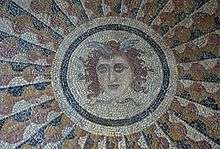
_02.jpg)
The mythological monster Medusa, her sisters, and the other Gorgons, have been featured in art and culture from the days of ancient Greece to present day. Medusa has been variously portrayed as a monster, a protective symbol, a rallying symbol for liberty, and a sympathetic victim of rape and/or a curse.
She is perhaps best recognized by her hair of living snakes and ability to turn living creatures to stone. Medusa is an ancient icon that remains one of the most popular and enduring figures of Greek mythology. She continues to be recreated in pop culture and art, surpassing the popularity of many other mythological characters.[1] Her likeness has been immortalized by artists including Leonardo da Vinci, Peter Paul Rubens, Pablo Picasso, Auguste Rodin and Benvenuto Cellini.[2]
Ancient times to the Renaissance
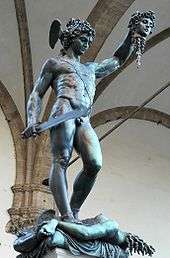
The Gorgoneion, or Gorgon head, known as Medusa, was used in the ancient world as a protective apotropaic symbol. Among the Ancient Greeks, it was the most widely used symbol to avert evil. Medusa's head with its goggling eyes, fangs, and protruding tongue was depicted on the shield of Athena herself.[3] Its use in this fashion was depicted in the Alexander Mosaic, a Roman mosaic (ca. 200 BC) in Pompeii. In some cruder representations, the blood flowing under the head can be mistaken for a beard.
By the Renaissance, artists depicted Medusa's head held aloft to represent the realistic human form of the triumphant hero Perseus (such as in the 1554 bronze statue Perseus with the Head of Medusa by Benvenuto Cellini). Medusa's head was also depicted to evoke horror by making the detached head the main subject (as demonstrated by the 1597 painting Medusa by Baroque originator Caravaggio).[4]
19th century
After the French Revolution, Medusa was used as a popular emblem of Jacobinism and was often displayed as a figure of "French Liberty." This was in opposition to "English Liberty," which was personified by Athena (whose shield bore Medusa's head).[5] "To radicals like Percy Bysshe Shelley, Medusa was an 'abject hero,' a victim of tyranny whose weakness, disfiguration, and monstrous mutilation [had] become, in themselves, a kind of revolutionary power."[6] Shelley's 1819 poem, On the Medusa of Leonardo da Vinci in the Florentine Gallery was published posthumously by his wife Mary Shelley in 1824.[7] Octave Mirbeau's use of Medusa during his time has also been examined.[8]
Modern use
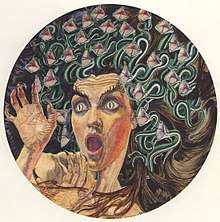
The image of Medusa's severed head has become one of the most-recognized images from Greek mythology. A representation of Perseus carrying this head has been featured on the cover of a number of paperback editions of Edith Hamilton's Mythology and several editions of Bulfinch's Mythology.[2] Medusa has appeared many times in animation, and her sisters are mentioned in Charles Dickens' A Tale of Two Cities. Medusa also became a very popular icon in designer fashion, as the logo of the Italian luxury clothing brand Versace portrays a Gorgon head.
Literature
In Rick Riordan's The Lightning Thief, Medusa is a minor antagonist who is killed by Percy Jackson (using a yard globe to avoid her paralyzing stare). He is successful because although Medusa hates Athena's daughter, Annabeth Chase, she still loves Poseidon (Percy's father). In The Son of Neptune, her sisters Stheno and Euryale are servants of Gaea intent on killing Percy in retaliation for his murder of their sister. In The Mark of Athena, the Gorgons' parents (Phorcys and Keto) and Medusa's son (Chrysaor) are antagonists.
The Gorgon is Natasi Daala's flagship in Kevin J. Anderson's Jedi Academy Trilogy.
In S.J Kinciad's Insignia series, Medusa, the code-name for a Russo-Chinese Combatant, is used as a description for the girl behind the name. The name is particularly apt, for the Combatant's face is permanently marked with scars and destroyed flesh, terrifying men. When Tom Raines defeats her at the Capitol Summit in Insignia, it can also be considered a reference to the way Perseus slew Medusa using a mirrored shield.
In Kendra Preston Leonard's poem, "Professor Medusa," Medusa teaches Greek Language and Literature at a college, where she tries to protect her students.
Television
A Gorgon is a villain in an episode of the TV series Blood Ties, where her transformation is the result of her having been raped in a temple; she becomes a monster as punishment for defiling the temple, and now turns men to stone if they come too close to her emotionally in the belief that they will hurt her just like her past rapist.
Medusa (played by Jemima Rooper) appears in the BBC One series Atlantis before she became a Gorgon. She was initially an ally of Jason and a love interest for Hercules, but Jason was warned that Medusa's destiny as a monster was inevitable. She transformed into a Gorgon when she opened Pandora's Box (which Jason recovered to rescue her when she was abducted), and was forced to flee Atlantis when everyone who sees her (except Jason) turns to stone. Although he has attempted to find a cure, Jason is warned that he will some day have to choose between saving Atlantis or Medusa.
In the 1968 Doctor Who story The Mind Robber, the Second Doctor and his companions (Jamie McCrimmon and Zoe Heriot) travel to the Land of Fiction. In a Labyrinth the Doctor and Zoe encounter Medusa, but when the Doctor denies her reality she becomes a statue. The Gorgons also appear in the Doctor Who spin-off series The Sarah Jane Adventures, with Elizabeth Sladen as former companion Sarah Jane Smith. In "Eye of the Gorgon", the Gorgon being portrayed as an alien parasite using a human host to try and create a portal to its world so that its species can invade. It is revealed that these aliens were the basis for the myth, having come to Earth three thousand years ago. One was the fabled Medusa who was killed by Perseus, another was killed about fifty years before the events of the episode by an archeologist and the last was killed when Maria Jackson used a mirror to reflect the Gorgon's attempt to turn Sarah Jane to stone back on it.
In Monster High, she has a son named Deuce Gorgon. He wears sunglasses to not turn his friends into stone.
Medusa made an appearance in the fantasy-drama series Once Upon a Time in the episode The New Neverland. This version is for some reason present in the Enchanted Forest and was killed by Snow White during her honeymoon with Prince Charming. Snow used a reflection to force Medusa into looking at her own eyes, transforming her to stone.
In the 2013 entry for the Kamen Rider series, Kamen Rider Wizard, Medusa exists as a Phantom born from the body of Misa Inamori, the twin sister of Mayu Inamori. She is one of two Phantoms tasked by Wiseman to create more Phantoms. Her Phantom form carries the signature petrification gaze, but she considers it her secret weapon and has only used it once.
In Conan the Adventurer (animated series) episode, Men of Stone, Medusa is portrayed as a man instead of a woman.
In Tales from the Cryptkeeper episode, Myth Conceptions, Medusa plays a role when an archaeologist discovers her tomb and learns the hard way why others before him have died trying to find it. In the end, he pays the price for taking the golden shield by becoming a statue himself by Medusa.
In Uchu Sentai Kyuranger, the Hebitsukai Voyager (Hebitsukai Silver's Voyager) is based on Medusa.
Medusa is a central character of the fantasy anime Fate/stay night where she is summoned to the modern era in her pre-gorgon form as a heroic spirit. Entities that embody the concept of being a hero in life, by their myth and their legend. She is summoned as a Rider class servant and serves as an antagonist or protagonist depending on which version of Fate/stay night's stories.
Films
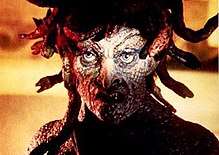
The myth of the Gorgon was the basis for the 1964 Hammer horror film, The Gorgon, which "abandoned the traditional myth entirely and tried to tell a new story".[9]
In the Italian sword and sandal comedy Arrivano I Titani, a Gorgon appears performed by an uncredited actress wearing live snakes in her hair.
Medusa was a character in the 1981 film, Clash of the Titans.[10] Special-effects creator Ray Harryhausen used stop motion animation to depict the battle with Medusa. Although "the essential story sticks closer to its sources than any other interpretation", the film takes creative liberties and Medusa's biology differs from "any previous representations, ancient or modern".[11] Medusa is also featured in the 2010 remake of the film, with her face appearing human until it contorts as she turns her victims to stone.[12]
Medusa appears in the film, Percy Jackson & the Olympians: The Lightning Thief (played by Uma Thurman), where she attacks Percy Jackson and his friends as they are looking for the Pearl of Persephone in her garden (which has statues: people she has turned to stone). When Percy's friends drive a car through a wall Medusa is distracted and Percy decapitates her before escaping.
In the film Miss Peregrine's Home for Peculiar Children, the two masked twins' "peculiarity" is revealed to be that they are Gorgons, with serpentine faces and the ability to petrify.
Medusa appears in The Lego Batman Movie, as one of the inmates of The Phantom Zone. She is voiced by Lauren White.
Video games
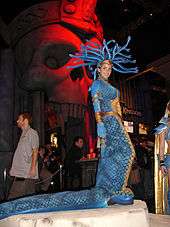
Medusa and her Gorgon sisters have been featured in gaming since the advent of role-playing games (RPGs):
- Medusa is a boss type monster in Dungeons and Dragons while gorgons are viewed as iron-hided ox-like creatures who exhale a gas which turns victims to stone.
- Medusas and gorgons appear in a similar fashion in Pathfinder Roleplaying Game. Additionally, there is a more powerful race of medusa matriarchs called the euryale.
- Medusa served as the inspiration for Yunalesca in Final Fantasy X, who appears during her second (and final) form to be modeled after her.
- The God of War series has Gorgons as enemies: scaly, reptile-like women with serpentine lower bodies and snakes for hair.[13][14] Medusa is a boss in God of War (2005), as is Euryale in God of War II (2007): main character Kratos slays both, taking their heads as weapons that can briefly turn enemies to stone. Stheno appears in the prequel, God of War: Ascension (2013) in its multiplayer mode.
- Medusa is the primary antagonist in the Nintendo Entertainment System game Kid Icarus and the Nintendo 3DS game Kid Icarus: Uprising.
- Medusa is a boss in the NES game series Adventures of Lolo that can instantly kill the player with a single glance.
- In The Legend of Zelda: Ocarina of Time, statues of snake women appear throughout the Spirit Temple. The item Link obtains in this dungeon; the Mirror Shield is based on Perseus' shield and at one point, Link must use the Mirror Shield to shine light on one of the statues to advance further.
- Medusa was resurrected by King Lassic in the first Phantasy Star game in order to guard the Laconian Axe and transformed Odin into stone.
- Medusa appears as a recurring boss in the Castlevania series.
- In addition to Medusa herself, there is also a recurring type of enemy known as "Medusa Heads" which are depicted as small floating heads that resemble Medusa and some are capable of petrifying the player if they come in contact with one of the heads. In some games, Medusa Heads continuously spawn in areas, making traversing these areas (especially when said area contains platforming elements and/or hazards) more difficult due to their ability to petrify. However Medusa Heads are generally weak enemies that can be killed with few hits and usually act as more as an obstacle, especially in areas where the spawn continuously. Within the series, Medusa Heads are said to either be spawned from the hair/head of Medusa or spawned from her severed head. In Castlevania: Symphony of the Night, an item called Medusa Shield can be obtained a random drop from defeated Medusa Heads. It is one of the two shields in the game that can be used by Alucard offensively as a weapon, as it damages enemies that come into contact with it. When used in conjunction with certain items, Alucard can use the shield to summon Medusa's Head to fire a laser attack. The shield itself is a reference to the Aegis Shield. In Circle of the Moon, using the Saturn and Cockatrice cards, Nathan Graves can summon a Medusa Head that spits out a rock. In both Aria of Sorrow and Dawn of Sorrow, the Medusa Head Guardian Soul (obtained from Medusa Heads) grants Soma Cruz the ability to levitate in mid-air. In Castlevania: Portrait of Ruin, Medusa Heads randomly drop the items, the Medusa Whip and Summon Medusa spell. The Medusa Whip is a weapon that can be equipped by Johnathan Morris and has the power to petrify enemies. The Summon Medusa spell allows Charlotte Aulin to summon the head of Medusa herself to fire a petrifying ray from her eyes.
- In Castlevania: Lords of Shadow 2, Medusa and her sisters are depicted as servants of Gabriel Belmont/Dracula. In this game, they are depicted as having once been the beautiful siblings among the Old Gods. During the fall of the City of Agharta, the three sisters escaped into the deep depths of the earth and became twisted shadows of their former selves, while retaining the macabre appearances of little girls. Over the many years they have survived by obsessively staying together. Their lair would become part of the City of the Damned under Dracula's castle, where they became his loyal followers. While trying to regain his former powers, Gabriel learns from the memory of his son Trevor that the Gorgon sisters hold Dracula's Chaos Claws. Upon finding Euryale, she tells him that the Castle's Jailers have turned against him and Stheno informs Dracula that Medusa has the claws. Dracula enters the Gorgon's lair, and among the endless petrified victims he retrieves his power. The three sisters reunite, only to learn that Medusa has been corrupted by the Castle's blood (controlled by Inner Dracula the personification of his vampiric powers) and infects her sisters as well. The blood takes them in and combines them into a singular mighty Gorgon that battles Gabriel as a boss. After defeating the Gorgon using the Chaos Claws, Gabriel obtains the Primordial Chaos Gem from its heart which grants him the power to use Chaos Bombs and expands his Chaos Claw attack options.
- Medusa and her sisters appear in Titan Quest, with various other gorgon enemies throughout the game's first act set in Greece.
- Medusa is the Heroic Spirit of the Rider-class Servant in the 5th Holy Grail War in the Japanese visual novel Fate/stay night. The sequel, Fate/hollow ataraxia, reveals that she killed Stheno and Euryale after having been transformed into her demonic gorgon form losing all of her sense of self beyond being a monster, it's also reveals that Medusa truly loved them and they her and still misses them. The three of them are playable in the mobile game Fate/Grand Order, where Medusa also has a younger form and her Gorgon form.
- Medusa is also an enemy in Terraria who turns you to stone if she uses her deadly gaze attack and you are looking in her general direction. This lasts for one to four seconds.
- Gorgons appears as a unique type of enemy in Destiny. They appear specifically in the Gorgons' Labyrinth section in the Vault of Glass raid, and look like glowing versions of Harpies, another enemy type. When one spots you, the entire fireteam has the "Gorgon's Gaze" debuff. If the Gorgon that gave this debuff is not killed within 6 seconds after applying it, the entire fireteam will die. Each time a Gorgon is killed, the rest become more aware and have longer initial immunity to damage.
- Medusa's Gaze, an in-game item, appears in PlayStation All-Stars Battle Royale; using it briefly turns opponents to stone.
- Medusa is the hellion form of Cardinal Forton in the game Tales of Zestiria, and the other 2 Forton sisters also appear as sidequest bosses, Stheno and Euryale. Notably, they are the only enemies in the game who can petrify.
MOBA
Medusa is also a rather popular influence in various multiplayer online battle arena games, often being used as an inspiration for a number of characters in the following titles:
- Medusa, the Gorgon, is a ranged agility character in Defense of the Ancients and its sequel Dota 2.
- Medusa, the Gorgon, is a ranged hunter god in Smite.
- Cassiopeia, the Serpent's Embrace, is a mage Champion in League of Legends.
- Vasj, the Naga Sea Witch, is a potential Hero in Heroes of the Storm.
- Midas is a melee strength Hero who has a custom skin labelled Coral Snake Medusa that features specially themed abilities in Heroes of Newerth.
Music
- British band UB40 produced a song ("Madame Medusa") for their 1980 album, Signing Off, drawing unfavorable comparisons between the mythological monster and United Kingdom Prime Minister Margaret Thatcher.
- U.S. thrash metal band Anthrax recorded a song titled "Medusa" for their 1985 album, Spreading the Disease, the lyrics of which were written by non-band member, Jon Zazula, their (& Metallica's) road manager at the time.
- Annie Lennox (of Eurythmics fame), titled her UK no.1, 2nd solo album Medusa. An album of cover-tunes, which contains no songs named Medusa.
- British extreme metal band Cradle of Filth recorded "Medusa And Hemlock" for their 2004 album, Nymphetamine.
- The Kagerou Project is a series of Vocaloid songs produced by Jin (Shizen no Teki-P) about ten children fighting for freedom. Several characters have red "eyes" giving them special abilities granted by the snakes of the Medusa Azami. Azami's daughter Shion and granddaughter Mary have Gorgon blood.
References
- ↑ Wilk, Stephen R. Medusa: Solving the Mystery of the Gorgon, June 26, 2000, Front matter, ISBN 0-19-512431-6.
- 1 2 Wilk, Medusa: Solving the Mystery of the Gorgon, pg. 200
- ↑ Jane Ellen Harrison, Prolegomena to the Study of Greek Religion, pp 196ff.
- ↑ Might Medici, By Robert Hughes, Time, Dec. 05, 2002
- ↑ Judson, B. (2001). The Politics of Medusa: Shelley's Physiognomy of Revolution. ELH. 68(1), 135-154.
- ↑ "Ekphrasis and the Other" by W. J. T. Mitchell, excerpted from Picture Theory(The University of Chicago Press);the paper originally appeared in South Atlantic Quarterly XCI (Summer 1992), pg. 695-719.
- ↑ Shelley, Percy Bysshe. The Complete Poems of Percy Bysshe Shelley, 14 June 1994, pg. 621, ISBN 0-679-60111-2.
- ↑ Claude Herzfeld, La Figure de Méduse dans l'œuvre d'Octave Mirbeau, Librairie Nizet, Paris, 1992, 107 pages.
- ↑ Wilk, Medusa: Solving the Mystery of the Gorgon, pg. 207.
- ↑ Wilk, Medusa: Solving the Mystery of the Gorgon, pg. 209.
- ↑ Wilk, Medusa: Solving the Mystery of the Gorgon, pg. 210.
- ↑ http://scifiwire.com/2009/12/medusa-kraken-revealed-in.php
- ↑ Medusa the Gorgon - Atmosfear.com.au Archived 2007-09-30 at the Wayback Machine.
- ↑ "GameBanshee-Titan Quest Walkthrough". Gamebanshee.com. Retrieved 2014-06-12.